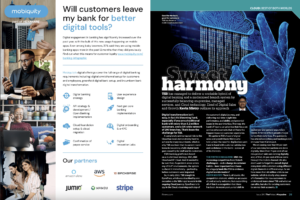Breaking News

EXCLUSIVE: “Sweet Harmony” – Kavin Mistry, TSB in ‘The Fintech Magazine’
TSB have managed to deliver a workable hybrid of digital banking and a modernised branch system by successfully balancing on-premise, managed services, and Cloud technology. Head of Digital Sales and Growth Kavin Mistry outlines its approach 
Digital transformation isn’t easy, in fact it’s blooming hard, especially if you are a traditional bank with more than 5.2 million customers, and a UK-wide network of 290 branches. That’s been the challenge for TSB. A completely uninterrupted ride to the Cloud has been demonstrably hard to achieve for many incumbents, which is why TSB was keen that its current march towards becoming a fully digital bank goes smoothly for staff and its customers. TSB’s banking platform is based on a multi-Cloud strategy: AWS, IBM Cloud and BT Cloud.
And it wanted to be sure that, if a problem arose across any of its IT environments, the system surfaced it immediately – preferably, before customers were impacted. So, in early 2022, TSB brought in DynaTrace, which was described by one executive as the ‘killer app’ to assist in this ongoing Cloud journey.
DynaTrace is its spy in the Cloud, observing each step of the customer’s digital journey, and delivering real-time insight into performance, availability, and potential issues in the user interface. That way, the bank’s IT teams can prioritise their focus on service enhancements that will have the biggest impact on customer experience.We spoke to TSB’s head of digital sales and growth Kavin Mistry who told us how the need for digitisation went hand in hand with customer satisfaction and confidence in the bank – across all of its channels.
THE FINTECH MAGAZINE: With the increasing competition from fintech challengers – and a change in customer habits – how important has it been for a legacy bank like TSB to embrace digital transformation?
KAVIN MISTRY: There is, of course, the competition element, which we are aware of, and actually welcome, but overarching all of that is a recognition that there has been, in recent years, a real shift in customers’ and general population trends, in terms of how people choose to live their daily lives. The pandemic has altered everything and banking is not immune from that impact. We are seeing now that 90 per cent of our servicing transactions are done digitally. More than 75 per cent of our new product sales are coming digitally, and, of that, 80 per cent of those come through the mobile channel. We also don’t want to forget the overall digital ecosystem with customers using different digital channels in different ways. So we have more than 60 million visits to our website, which is clearly a key source of information for new customers to understand more about TSB and what we can offer, but also for existing customers to service their accounts.

It’s important to note that customers are using multiple channels, depending on what their need is. Increasingly, they are willing to embrace the digital channels to do their everyday banking; but also having that human touch, where they may have more complex needs, is important. For example, big one-off purchases, like buying a home, may require more face-to-face interaction as will more sensitive needs, such as a bereavement in the family, that can lead to many complex financial situations, so it probably warrants more face-to-face and human contact.
FF: That’s an interesting point you make about customers still needing face-to-face contact, especially as the number of high street branches across the whole sector declines. How do you square that paradox when discussing the digitisation of TSB’s offering?
KM: I think it’s important to look at the role of the branch in this context, with the role of physical presence versus digital presence evolving in recent times. Previously, you would have customers who maybe stuck more to their channel of choice, say doing all of their banking through branches and branch colleagues. They naturally would’ve been more reticent to deal with banking themselves. Whereas, what the pandemic appears to have done is to put the onus on customers to do some of their everyday banking digitally and more remotely, using things like the TSB mobile app. But for more complex needs, they can visit a branch, or speak to somebody on our telephony lines. In this new environment, the branch provides more of a support structure for customers who are interested in digital adoption, but are afraid to take those first tentative steps. The onboarding journey that we have launched is actually being used in our branches, so that customers can self-learn, and self-apply, to get themselves well-versed in how to use not only the onboarding journey, but the mobile app, too, more holistically. We’re offering a hybrid approach of digital complementing a face-to-face modern branch network, providing customers the best in both digital and traditional banking.
TFM: You mentioned TSB’s digital onboarding, what are some of the friction points for an organisation of your size?
KM: We think about this in two different ways – protecting the customer and helping customers navigate what can be quite a complex landscape. From a friction point of view, we try to allow the customer to have all the information at their disposal, in order to make an informed decision on which product they would like to go for. We like to make it very clear, and very intuitive. We want the customer to make that choice, in terms of what is the right product that suits them. 
The second thing is recognising that navigating an onboarding journey, historically, can be quite cumbersome, so we have used a lot of research to inform our design, to make that as slick and as easy as possible and very intuitive. At the same time, we wanted to address some of the other things that customers find quite challenging, like issues around the know-your-customer and identity and verification process.We provide very, very clear instructions, and allow for feedback loops, so that the customer doesn’t make a mistake – and they can get the decision pretty much instantaneously with zero friction.There is also the daunting nature of credit decisioning, so we’ve strived to provide very clear instructions about what we are actually doing at our end, and how that can affect the customer, before we make a decision for them.
And finally, I think we remember that it’s not just important to focus on the onboarding journey; we also look at what comes after that for the customer. For example, we give very clear information in the journey about when to expect their various bits and pieces through the post. We’ve also followed that up with a review of our welcome experience for customers, so that the customers can not only make the most of their banking experience with TSB, but they can also make the most out of the product they have secured from us.
TFM: One would suspect that one barrier to some customers digitally onboarding is concern around security. Tell us more about your partnership with Onfido, which seeks to alleviate those fears while ensuring a quick and satisfactory onboarding experience.
KM: As you say, we’ve partnered with Onfido to provide our verification process and this allows customers to access mobile banking in just 10 minutes – that involves just 22 questions to open an account, but with security front and centre. We check that the customer’s ID is genuine, matching it to the user’s face using biometric technology and there is also email and device verification for increased protection.Behind the scenes, we also have anti-money laundering checks, industry-wide fraud checks. But all of this is performed quickly and efficiently, meaning we’re one of the first high street banks to have instant mobile registration through the signup journey.
That also means that customers don’t have to wait to receive an activation code in the post; after 10 minutes, they have instant access to the TSB mobile banking app and their account details. Underpinning everything is Cloud technology, which actually allows a lot of those complex processes that happen behind the scenes to occur much more quickly and at scale. And so, when we are fully ramped up, and delivering thousands of customers’ onboarding experiences simultaneously, we don’t have those annoying, nagging glitches that some customers experience.
This article was published in The Fintech Magazine #24, Page 29-30
People In This Post
Companies In This Post
- Coincover Launches Protected Co-Signing for Ultimate Transaction Protection Read more
- Nordnet Appoints Gabrielle Hagman as New Country Manager Sweden Read more
- Creditinfo Appoints TransUnion Veteran as New Global Chief Commercial Officer Read more
- Marqeta and Rain Announce Partnership to Deliver Robust Earned Wage Access Through Embedded Finance Read more
- Fiserv Corporate Social Responsibility Report Highlights Progress on Commitment to Sustainable Business Read more














